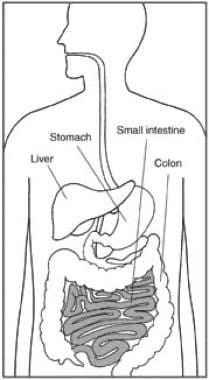Background
Lactose intolerance in adulthood is very common and is the result of a genetically programmed progressive loss of the activity of the small intestinal enzyme lactase. Some scientists believe that human adult lactase polymorphism evolved in the Neolithic period, after animal milk became available for the nutrition of older children and adults. Expression of the lactase enzyme starts to decline in most persons at age 2 years; almost 4 billion people worldwide have lactose malabsorption. However, symptoms of lactose intolerance rarely develop in people younger than 6 years.
Milk intolerance is more frequently due to milk-protein allergy than primary lactase deficiency. Although transient lactose intolerance may occur during acute gastroenteritis and as part of any process that leads to reduction of the small intestinal absorptive surface (such as untreated celiac disease), it is rarely clinically significant and, when present, can be easily treated with a short course of a lactose-free diet. Diagnosing lactose intolerance based on symptoms is fairly inaccurate; however, self-reported symptoms of lactose intolerance correlate with low calcium intake. Calcium supplementation should accompany any restriction of milk products.
Pathophysiology
Lactose, a disaccharide unique to mammalian milk, is hydrolyzed into the monosaccharides glucose and galactose at the brush border of enterocytes on the villous tip by the enzyme lactase (a beta-D-galactosidase known as lactase phlorizin hydrolase).
Lactose appears to enhance the absorption of several minerals, including calcium, magnesium, and zinc. The small intestine is a major site of absorption and is illustrated in the image below.
It also promotes the colonic growth of Bifidobacterium and is the source of galactose, which is an essential nutrient for the formation of cerebral galactolipids. The gene for lactase is located on chromosome 2. Hypolactasia seems to be strongly correlated with genotype C/C of the genetic variant C-->T(-13910) upstream of the lactase phlorizin hydrolase gene.
The molecular bases of lactose intolerance have been reviewed. [1]
Human and animal studies suggest that numerous modulators result in variable expression of lactase at different ages. Thyroxine may promote the decline in lactase enzyme expression that appears in childhood, whereas hydrocortisone appears to increase lactase levels. Although premature infants have partial lactase deficiency because of intestinal immaturity, enzyme expression can be induced by lactose ingestion. Improvement of lactose digestion in a previously intolerant child or adult is caused by growth of lactose-digesting bacteria rather than an induction in activity of the lactase enzyme because lactase is a noninducible enzyme.
Congenital lactase deficiency is an extremely rare autosomal recessive disorder associated with a complete absence of lactase expression. Childhood-onset and adult-onset lactase deficiency are extremely common and are inherited in an autosomal recessive manner. The CC genotype of the 13910 C/T polymorphism of the LCT gene is linked to such late-onset primary hypolactasia. Persistent lactase activity into adulthood is inherited in an autosomal dominant manner. Acquired lactase deficiency, which is a transient phenomenon by definition, is due to damage of the intestinal mucosa by an infectious, allergic, or inflammatory process and resolves once the disease process is corrected and healing of the intestinal mucosa restores the brush border enzymes.
Epidemiology
Frequency
United States
Although as many as 20-25% of white US adults are believed to be lactase deficient, the true prevalence of this condition is unknown, as noted in a comprehensive National Institute of Health (NIH) consensus conference on the topic. [2] The prevalence in other racial groups parallels the country of racial origin. Symptomatic individuals represent only about 50% of lactase deficiency cases.
On average, both African Americans and Hispanic Americans consume less than the recommended levels of dairy foods, and perceived or actual lactose intolerance can be a primary reason for limiting or avoiding dairy intake, while true lactose intolerance prevalence is not known in these populations. A recent consensus statement provides an updated overview of the extent of this problem in such populations. [3]
International
Adult-onset lactase deficiency varies widely among countries. Northern Europeans have the lowest prevalence at approximately 5%. Central Europeans have a higher prevalence at approximately 30%, and Southern Europeans have a much higher prevalence at approximately 70%. Hispanic and Jewish populations also have a high prevalence at approximately 70%, while Northern Indians have a much lower prevalence than Southern Indians, at approximately 25% and 65%, respectively. Almost all (90%) Asians and Africans are affected.
Mortality/Morbidity
Usually, very little morbidity is associated with lactase deficiency. Transient lactase deficiency affects a significant number of infants with severe gastroenteritis and diarrhea. Symptoms generally resolve within 5-7 days.
Race
See Frequency.
Sex
No sex differences in the prevalence of adult-type hypolactasia are known.
Age
Lactase activity in the fetal intestine progressively increases through the third trimester and approaches maximum expression at term. Preterm infants have diminished levels of lactase. Few infants born at 28 weeks' gestation have significant intestinal lactase activity, whereas approximately 40% of infants born at 34 weeks' gestation demonstrate significant intestinal lactase activity. The premature neonatal period is the only time in which lactase enzyme production and expression can be induced. Because congenital lactase deficiency is exceedingly rare, diagnoses such as glucose-galactose malabsorption or the much more common milk-protein allergy should be considered in an infant with symptoms of milk or milk-based formula intolerance.
Lactase activity is genetically programmed to decline, beginning after age 2 years. Signs and symptoms usually do not become apparent until after age 6-7 years, and recent studies have actually shown that hypolactasia may begin even after age 20. [4] Symptoms, therefore, may not be apparent until adulthood, depending on dietary lactose intake and rate of decline of intestinal lactase activity. Lactase enzyme activity is highly correlated with age, regardless of symptoms.
Secondary lactase deficiency due to intestinal mucosal injury can appear at any age; however, children younger than 2 years are very susceptible because of many factors, including a high sensitivity of the gut to infectious agents, low reserve because of the small intestinal surface area, and high reliance on milk-based products for nutrition.
-
The small intestine is a major site of absorption.





